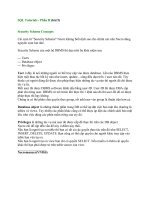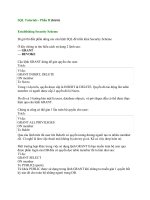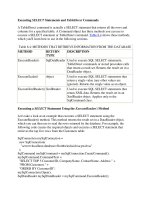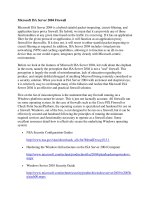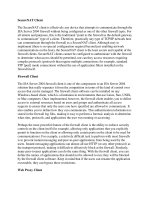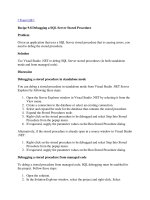Executing SQL Server Stored Procedures phần 1
Bạn đang xem bản rút gọn của tài liệu. Xem và tải ngay bản đầy đủ của tài liệu tại đây (30.92 KB, 6 trang )
Executing SQL Server Stored Procedures
In Chapter 4
, you saw how to create and execute SQL Server stored procedures using T-
SQL. You execute a stored procedure using the T-SQL EXECUTE statement. In this
section, you'll see how to execute SQL Server procedures using ADO.NET.
In Table 8.1
, shown earlier in this chapter, I mentioned the CommandType of
StoredProcedure. Although you can use this CommandType to indicate that a command
is to execute a stored procedure, you're actually better off using the T-SQL EXECUTE
command to execute a stored procedure. This is because you can read values that are
returned from a stored procedure through a RETURN statement, which you can't do
when setting the CommandType to StoredProcedure. Also, it's a lot easier to understand
your code when you use the EXECUTE command.
There are a couple of ways you can execute a stored procedure depending on whether
your procedure returns a result set (a result set is one or more rows retrieved from a table
by a SELECT statement). You'll learn these two ways to execute a stored procedure next.
Executing a Stored Procedure That Does Not Return a Result Set
If your procedure does not return a result set, then you use the following steps to execute
it:
1. Create a Command object and set its CommandText property to an EXECUTE
statement containing your procedure call.
2. Add any required parameters for the procedure call to your Command object,
remembering to set the Direction property for any output parameters to
ParameterDirection.Output. These output parameters can be defined using the T-
SQL OUTPUT keyword in your procedure call, or returned using a RETURN
statement in your actual procedure.
3. Execute your Command object using the ExecuteNonQuery() method. You use
this method because the procedure doesn't return a result set.
4. Read the values of any output parameters.
You'll see how to use these four steps to call the following two SQL Server stored
procedures:
•
The first procedure, AddProduct(), will return an output parameter defined using
the OUTPUT keyword.
•
The second procedure, AddProduct2(), will return an output parameter using the
RETURN statement.
These examples will show you the possible ways to execute a stored procedure using
ADO.NET and read the output parameters.
Executing the AddProduct() Stored Procedure
In Chapter 4
, you saw how to create a stored procedure in the SQL Server Northwind
database. The procedure you saw was named AddProduct(), and Listing 8.11
shows the
AddProduct.sql script that creates the AddProduct() procedure. You saw how to run this
script in Chapter 4
. If you didn't already run this script when reading Chapter 4, and you
want to run the example C# program shown later, you'll need to run this script.
AddProduct() adds a row to the Products table and returns the ProductID of the new row
as an OUTPUT parameter.
Listing 8.11: ADDPRODUCT.SQL
/*
AddProduct.sql creates a procedure that adds a row to the
Products table using values passed as parameters to the
procedure. The procedure returns the ProductID of the new row
in an OUTPUT parameter named @MyProductID
*/
CREATE PROCEDURE AddProduct
@MyProductID int OUTPUT,
@MyProductName nvarchar(40),
@MySupplierID int,
@MyCategoryID int,
@MyQuantityPerUnit nvarchar(20),
@MyUnitPrice money,
@MyUnitsInStock smallint,
@MyUnitsOnOrder smallint,
@MyReorderLevel smallint,
@MyDiscontinued bit
AS
- insert a row into the Products table
INSERT INTO Products (
ProductName, SupplierID, CategoryID, QuantityPerUnit,
UnitPrice, UnitsInStock, UnitsOnOrder, ReorderLevel,
Discontinued
) VALUES (
@MyProductName, @MySupplierID, @MyCategoryID, @MyQuantityPerUnit,
@MyUnitPrice, @MyUnitsInStock, @MyUnitsOnOrder, @MyReorderLevel,
@MyDiscontinued
)
- use the SCOPE_IDENTITY() function to get the last
- identity value inserted into a table performed within
- the current database session and stored procedure,
- so SCOPE_IDENTITY returns the ProductID for the new row
- in the Products table in this case
SELECT @MyProductID = SCOPE_IDENTITY()
Notice the OUTPUT parameter named @MyProductID returned by AddProduct().
Because AddProduct() doesn't return a result set, you use the first set of steps outlined
earlier. Let's examine the details of these four steps to execute this stored procedure.
Step 1: Create a Command Object and set its CommandText Property to an
EXECUTE Statement
Your first step is to create a Command object and set its CommandText property to an
EXECUTE statement containing the call to AddProduct(); notice the parameter
placeholders used to mark the position where the parameter values will be substituted in
step 2:
SqlCommand mySqlCommand = mySqlConnection.CreateCommand();
mySqlCommand.CommandText =
"EXECUTE AddProduct @MyProductID OUTPUT, @MyProductName, " +
"@MySupplierID, @MyCategoryID, @MyQuantityPerUnit, " +
"@MyUnitPrice, @MyUnitsInStock, @MyUnitsOnOrder, " +
"@MyReorderLevel, @MyDiscontinued";
Notice the OUTPUT parameter placeholder named @MyProductID. This is used to store
the OUTPUT parameter returned by AddProduct(). The other parameter placeholders are
used to pass values to AddProduct(), which then uses those values in its INSERT
statement.
Step 2: Add Any Required Parameters to the Command Object
Your second step is to add any parameters to your Command object, remembering to set
the Direction property for any output parameters to ParameterDirection.Output.
In this example, AddProduct() expects an output parameter to store the ProductID for the
new row, and you therefore need to add an output parameter to your Command object.
You do this by setting the Direction property of your parameter to
ParameterDirection.Output. For example:
mySqlCommand.Parameters.Add("@MyProductID", SqlDbType.Int);
mySqlCommand.Parameters["@MyProductID"].Direction =
ParameterDirection.Output;
The other parameters required to call AddProduct() are:
mySqlCommand.Parameters.Add(
"@MyProductName", SqlDbType.NVarChar, 40).Value = "Widget";
mySqlCommand.Parameters.Add(
"@MySupplierID", SqlDbType.Int).Value = 1;
mySqlCommand.Parameters.Add(
"@MyCategoryID", SqlDbType.Int).Value = 1;
mySqlCommand.Parameters.Add(
"@MyQuantityPerUnit", SqlDbType.NVarChar, 20).Value = "1 per box";
mySqlCommand.Parameters.Add(
"@MyUnitPrice", SqlDbType.Money).Value = 5.99;
mySqlCommand.Parameters.Add(
"@MyUnitsInStock", SqlDbType.SmallInt).Value = 10;
mySqlCommand.Parameters.Add(
"@MyUnitsOnOrder", SqlDbType.SmallInt).Value = 5;
mySqlCommand.Parameters.Add(
"@MyReorderLevel", SqlDbType.SmallInt).Value = 5;
mySqlCommand.Parameters.Add(
"@MyDiscontinued", SqlDbType.Bit).Value = 1;
Notice that the SqlDbType parameter types correspond to the types expected by the
AddProduct() stored procedure. The values the parameters are set to are then substituted
for the placeholders in the EXECUTE statement shown in step 1.
Step 3: Execute the Command Object Using the ExecuteNonQuery() Method
Your third step is to execute your Command object using the ExecuteNonQuery()
method. You use ExecuteNonQuery() because the AddProduct() procedure doesn't return
a result set. For example:
mySqlCommand.ExecuteNonQuery();
Step 4: Read the Values of any Output Parameters
Your last step is to read the values of any output parameters. AddProduct() used one
output parameter named @MyProductID. You read this returned value from the Value
property of @MyProductID:
Console.WriteLine("New ProductID = " +
mySqlCommand.Parameters["@MyProductID"].Value);
This displays the values of the ProductID generated by SQL Server for the new row in
the Products table.
Listing 8.12
illustrates these steps to call the AddProduct() procedure.
Listing 8.12: EXECUTEADDPRODUCT.CS
/*
ExecuteAddProduct.cs illustrates how to call the SQL Server
AddProduct() stored procedure
*/
using System;
using System.Data;
using System.Data.SqlClient;
class ExecuteAddProduct
{
public static void Main()
{
SqlConnection mySqlConnection =
new SqlConnection(
"server=localhost;database=Northwind;uid=sa;pwd=sa"
);
mySqlConnection.Open();
// step 1: create a Command object and set its CommandText
// property to an EXECUTE statement containing the stored
// procedure call
SqlCommand mySqlCommand = mySqlConnection.CreateCommand();
mySqlCommand.CommandText =
"EXECUTE AddProduct @MyProductID OUTPUT, @MyProductName, " +
"@MySupplierID, @MyCategoryID, @MyQuantityPerUnit, " +
"@MyUnitPrice, @MyUnitsInStock, @MyUnitsOnOrder, " +
"@MyReorderLevel, @MyDiscontinued";
// step 2: add the required parameters to the Command object
mySqlCommand.Parameters.Add("@MyProductID", SqlDbType.Int);
mySqlCommand.Parameters["@MyProductID"].Direction =
ParameterDirection.Output;
mySqlCommand.Parameters.Add(
"@MyProductName", SqlDbType.NVarChar, 40).Value = "Widget";
